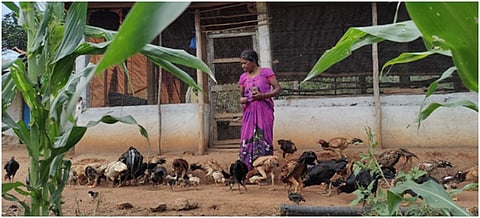Antimicrobial resistance: These tribal Andhra districts effectively use ethnoveterinary medicine for poultry care
Antibiotics are pumped into farm animals indiscriminately, leading to antimicrobial resistance (AMR) in poultry as well as humans. AMR refers to the ability of microorganisms such as bacteria, fungi, parasites and viruses to proliferate despite exposure to drugs designed to kill them or slow down their growth.
Some 4.95 million deaths were associated with, and 1.95 million deaths directly attributable to bacterial AMR across the world in 2019 according to a study in the journal, The Lancet.
In Andhra Pradesh’s tribal districts Alluri Seetha Ramaju (ASR) and Parvathipuram Manyam, poultry population becomes zero in villages where Ranikhet disease strikes.
The fatalities hurt household income and it takes six months to regain the bird population.
The formal poultry healthcare service system in these areas is almost non-existent. The local communities depend on local herbal remedies for seasonal diseases.
The proportion of tribal population was 82.67 per cent and 28.14 per cent in ASR and Parvathipuram Manyam respectively, according to the 2011 Census.
Tribal communities like Kodareddy, Konda Kammara, Koya Dora, Savara, Jathapu, Bagatha, Kotiya, Manne Dora and Konda Dora and Valmiki are predominant and livestock rearing is one of their major sources of livelihood.
Culturally, all tribal communities rear some indigenous poultry. A flock of 10-20 birds is the average holding of a family.
They also use indigenous poultry as offerings to their deities for protecting their crops and livestock. They celebrate 12 tribal festivals, and in each ritual, sacrificing and consuming poultry is compulsory.
Apart from this, tribal families consume poultry meat during family gatherings, such as when children, studying or working outside in cities return home.
Tribal communities manage their birds under a free-range system: They leave their birds out in the morning and keep them in huts during the night. The birds forage in the backyard for their food. Tribal women take some care of the flock, helping with shed management and feeding millet grains and bran.
Leading by example
Watershed Support Services and Activities Network (WASSAN), a public trust, has tried to strengthen the desi (local) poultry production system through the integration of indigenous knowledge, particularly on shelter, feeding and plant-based ethnoveterinary medicines.
Ethnoveterinary medicines are used extensively and effectively for primary healthcare of poultry, with the guidance of local herbal healers for the propagation of medicinal plants and preparation of herbal medicines.
The medicinal plants were prioritised based on the local herbal practitioner’s experiences. Species were also identified taxonomically and scientific evaluation was done for extensive promotion through posters and digital platforms.
WASSAN developed desi poultry-breeding farm entrepreneurs locally for supplying chicks to tribal women. Entrepreneurs manage farms in half-acre lands (generally old orchards) and develop forage areas to obtain enough feed material for birds.
In these breed farms, WASSAN promotes cultivation of medicinal plants used for treating poultry, such as Andrographis paniculata Burm.fil (Chiretta), Aloe vera (L.) Burm, Curcuma longa L. (turmeric), Acorus calamus L. (muscrat root), Ocimum sanctum L. (tulsi), Holarrhena antidysenterica L. Wall. ex A. DC. (kurchi), Cymbopogon citrarus DC. Stapf. (lemon grass), Carica papaya L.(papaya), Zingiber officinale L.var rubrum (ginger).
WASSAN also builds capacities of entrepreneurs in diagnosing diseases of birds, administration of lasota (RD F1) vaccine and preparation of herbal medicines.
In 2015, WASSAN established five desi poultry breed farms with the help of the animal husbandry department in the Seethampeta integrated tribal development agency region. By 2017, this was scaled up to 129 units.
Today, strengthening desi poultry management and indigenous knowledge systems has become a mainstream programme for the tribal welfare department.
Currently, there are about 350 desi poultry breeding farms managed by tribal women, and they serve 20,000 households of both ASR and Parvathipuram Manyam.
Tribal women make arrangements in nesting for hens to lay eggs. In the summer, they use tamarind seeds and paddy husk in winter to increase the hatchability rate.
They also perform fumigation once a month to control infestation of microorganisms. They use dry leaves of Annona squamosa L. (custard apple), Chloroxylon swietenia (Roxb.) DC (satin wood), Nicotiana tobaccum L. (tobacco), Azadirachta indica L.(neem) and Cymbopogon citratus DC. Stapf (lemon grass) for this purpose.
WASSAN has been integrating desi poultry in the community-managed natural farming villages to produce chemical-free chicken. The demand for desi poultry meat is increasing rapidly, due to consumers’ awareness of the nutritional value of this meat, which is even more so, if it is produced naturally.
As per the WASSAN experiences metabolic disease conditions are more responding to ethnoveterinary medicines in desi poultry. WASSAN has been testing for eradicating intestinal worm infestation, poultry lice, watery diarrhea, white diarrohea, bronchitis as well as cuts and wounds.
Marri Jame (62) belongs to a particularly vulnerable tribal group and lives along with her husband in the Chinasangham village of Pedalochili Gram Panchayat, G Madugula mandal, ASR district.
In 2018, she established a desi poultry unit in her old orchard of 0.5 acres with 40 hens and 10 roosters. She currently has more than 200 birds on her farm and earns Rs 60,000 per year as additional income apart from sale of fruits.
She is a herbal practitioner and manages her birds through ethnoveterinary medicine sources from plants grown inside the forage area.
It is more important to promote ethnoveterinary medicine in tribal areas since local communities have abundant access to medicinal plants as well as backyards to grow frequently used herbs. Local traditional healers are available to upscale the scientifically validated herbal medicine.
ML Sanyasi Rao is a programme manager at WASSAN
Views expressed are the author’s own and don’t necessarily reflect those of Down To Earth


